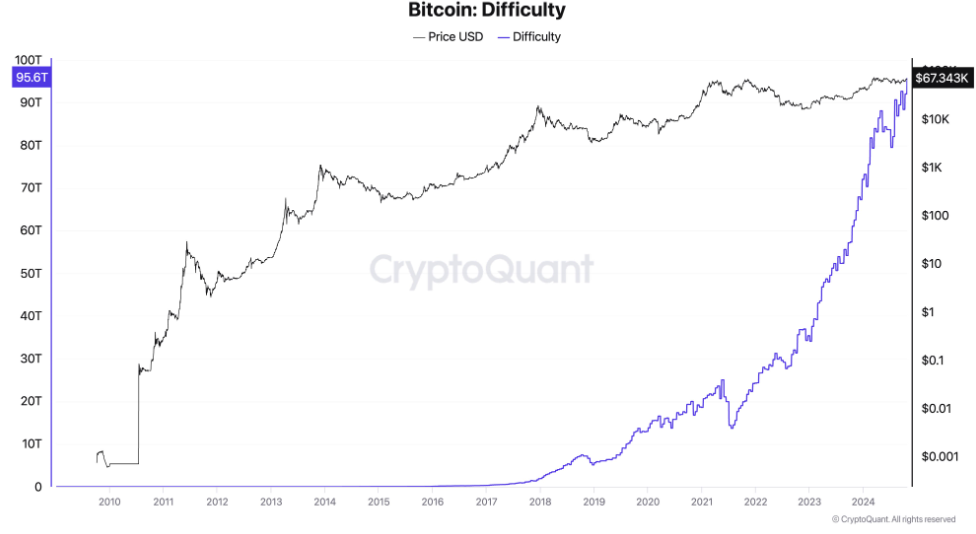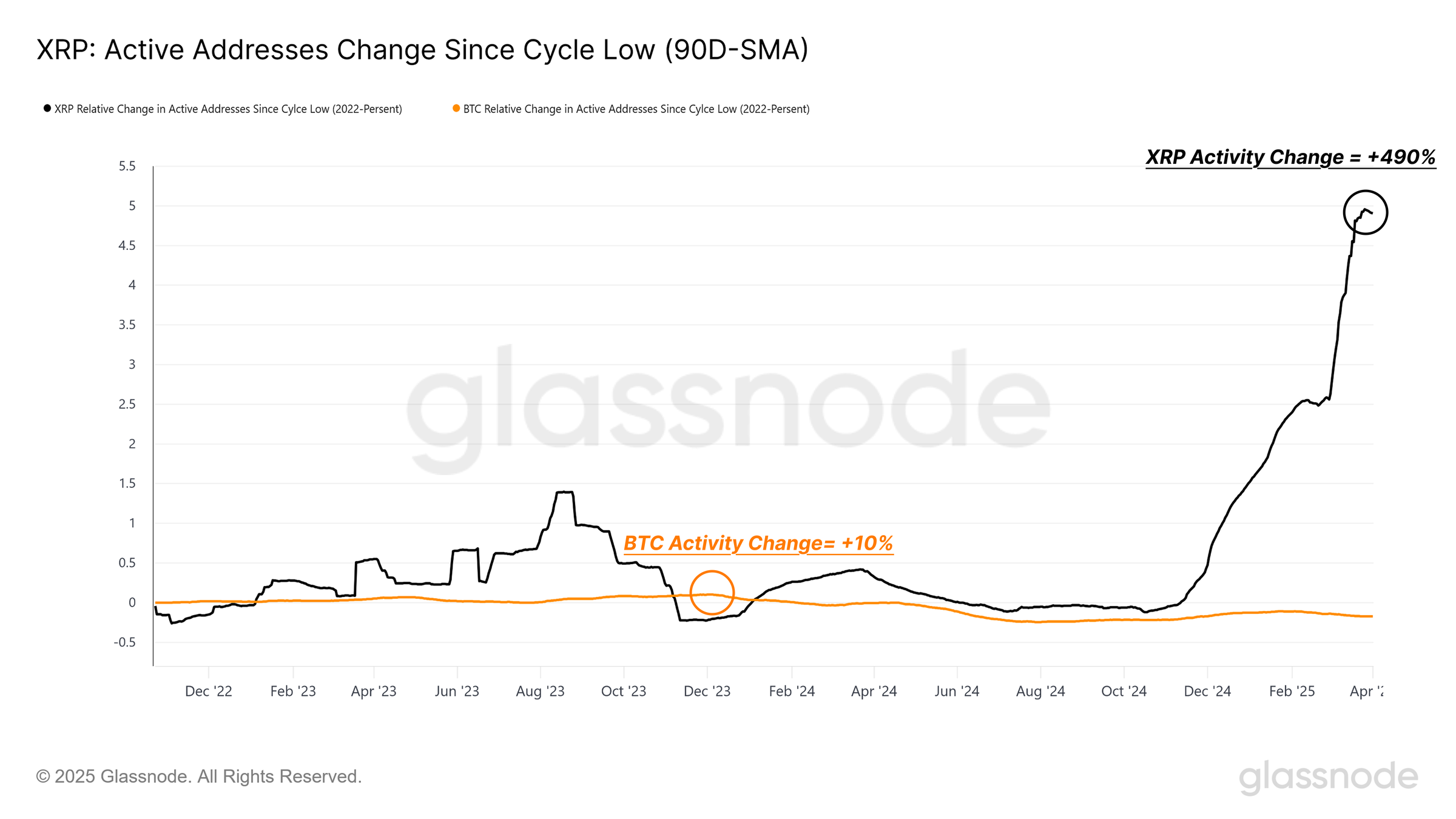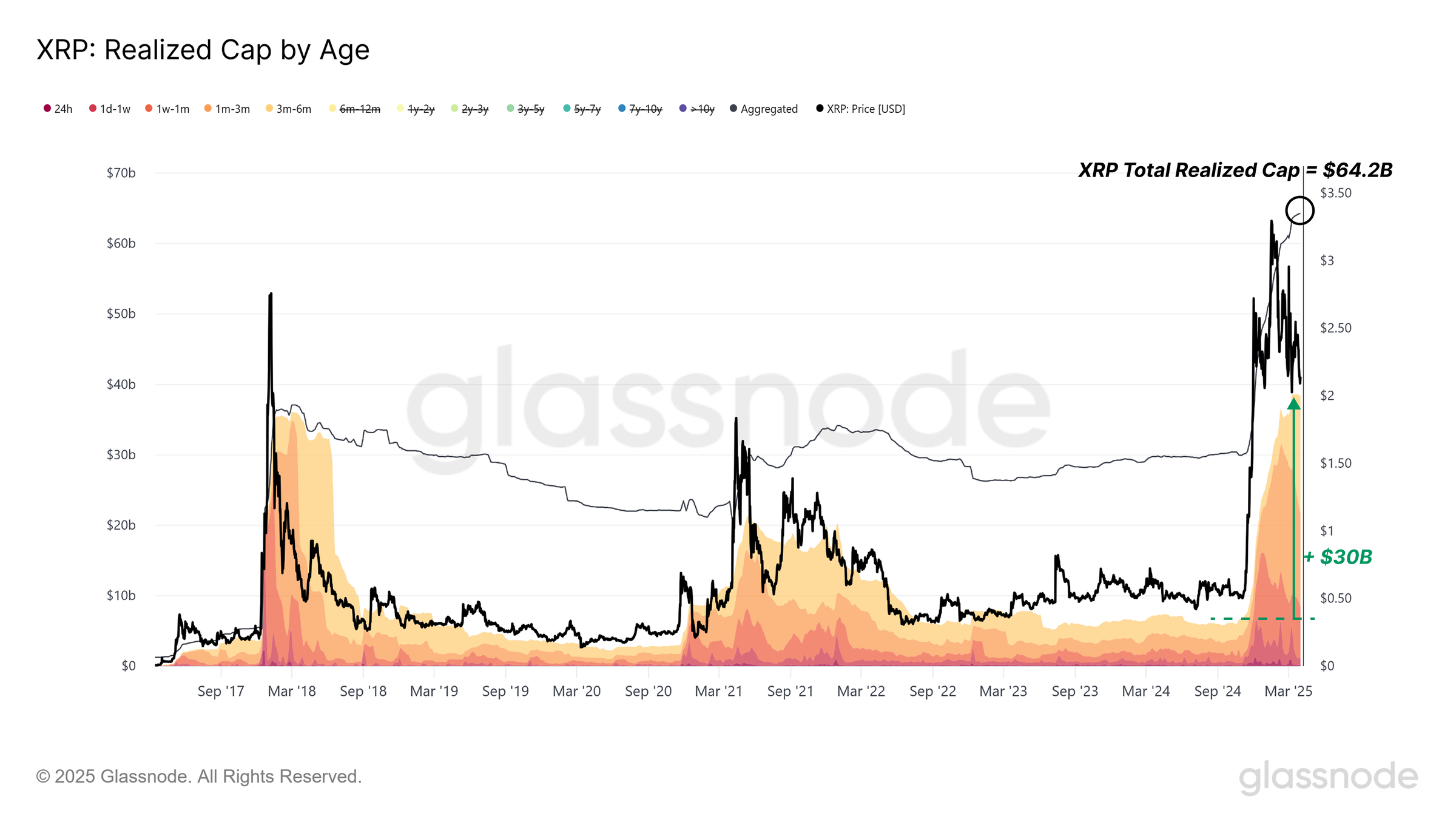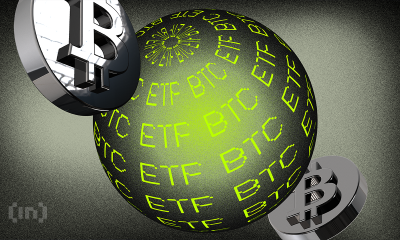Bitcoin
Bitcoin May Evolve Into a Currency by 2030

Bitcoin (BTC) could finally realize its potential as a global currency by 2030, according to a recent post by Ki Young Ju, CEO of CryptoQuant. Ki’s analysis highlights the rapid evolution of the Bitcoin ecosystem, particularly in mining and institutional involvement.
Satoshi Nakamoto, the mysterious creator of Bitcoin, once envisioned it as a decentralized, peer-to-peer (P2P) electronic cash system.
CryptoQuant Founder Envisions Bitcoin As A Future Currency
In the post on X (formerly Twitter), Ki hinted at a future where Bitcoin may be widely used as a low-volatility currency, not just a speculative investment asset. The vision is based on how Bitcoin mining has drastically changed since its inception in 2009.
Back then, individual miners could easily mine 50 BTC with a single personal computer. Today, the playing field is entirely different.
Bitcoin’s mining difficulty, which measures the complexity of mining new blocks, has surged by a staggering 378% in just the past three years. This reflects the increased competition within the industry, with the growth making it nearly impossible for individual miners to participate profitably.

Instead, large-scale mining companies backed by institutional investors now dominate the industry. This shift toward institutional control has had far-reaching consequences for Bitcoin’s future. As institutional investors take the reins, entry barriers to mining rise, and Bitcoin’s ecosystem grows more stable.
Read More: How To Buy Bitcoin (BTC) and Everything You Need To Know
Against this backdrop, Ki Young Ju suggests that stabilization could reduce Bitcoin’s infamous price volatility. Instead, it could make it less appealing to day traders but more attractive as a practical currency.
The CryptoQuant executive points to one key event – Bitcoin halving. This event occurs approximately every four years when the reward for mining Bitcoin transactions is cut in half. After the 2024 Bitcoin halving, the next one is expected to take place around April 2028.
Historically, significant price increases came after halving events. However, Ki Young Ju predicts that the 2028 halving could mark a new phase in Bitcoin’s evolution. As Bitcoin’s volatility decreases over time, the conversation around its use as a “currency” may begin in earnest by this time.
Institutional Adoption of Bitcoin To Soar By Next Halving
Ki Young Ju believes that by 2028, institutional adoption will reach a critical mass, paving the way for Bitcoin to become more widely accepted for everyday transactions. The increasing presence of major fintech companies could also play a role in Bitcoin’s transformation into a currency. For instance, Stripe’s recent foray into the stablecoin infrastructure space could draw more e-commerce and global markets.
As regulatory clarity emerges, stablecoins could see mass adoption. This could familiarize more people with blockchain wallets and other cryptocurrency-related technologies in turn.
Furthermore, volatility has long been a major barrier to Bitcoin’s use as a currency. Businesses and consumers are reluctant to use Bitcoin for transactions if its value fluctuates wildly from day to day. However, Ki Young Ju argues that this volatility is slowly decreasing as the ecosystem matures.
“As volatility decreases, Bitcoin’s role as a currency becomes increasingly inevitable,” Ju added.
This reduction may occur through advancements in protocol, Layer 2 (L2) networks, or the adoption of Wrapped Bitcoin (WBTC). Nevertheless, Ki Young Ju says for Bitcoin L2s to be competitive, they would need institutional support. As these improvements take hold, Bitcoin’s potential to serve as a stable currency grows.
This aligns with the vision of financial experts like billionaire investor Paul Tudor Jones, who sees Bitcoin as a hedge against inflation and economic uncertainty. Jones believes that Bitcoin’s finite supply, particularly in a world burdened by increasing debt and inflation, makes it an attractive store of value.
Similarly, MicroStrategy founder Michael Saylor believes Bitcoin’s unique properties make it a superior store of value over the long haul. This explains the business intelligence firm’s progressive BTC buying spree. The firm has been stacking Bitcoin since 2020 and is still holding.
This growing institutional trust could further stabilize Bitcoin’s price, enhancing its appeal as a currency by the end of the decade.
“We’re buying Bitcoin to hold it 100 years. That $66,000 to $16,000 crash shook out the tourists. When it was $16,000, we were all ready to ride it to zero,” Saylor said recently.
For Ki Young Ju, this transformation represents a return to Bitcoin’s original purpose. While many view Bitcoin as “digital gold,” Satoshi Nakamoto’s true aim was for it to function as a P2P electronic cash system.
Read more: Satoshi Nakamoto – Who is the Founder of Bitcoin?
As the ecosystem matures and volatility continues to decrease, the perception that Bitcoin cannot be a currency no longer exists. CryptoQuant’s founder believes the world could see Bitcoin used as a practical, low-volatility currency by 2030, effectively realizing Satoshi’s long-held dream.
Disclaimer
In adherence to the Trust Project guidelines, BeInCrypto is committed to unbiased, transparent reporting. This news article aims to provide accurate, timely information. However, readers are advised to verify facts independently and consult with a professional before making any decisions based on this content. Please note that our Terms and Conditions, Privacy Policy, and Disclaimers have been updated.
Bitcoin
Japanese Company Unveils Plans To Buy Crypto


Enish, a Japanese game developer, plans to buy Bitcoin worth 100 million yen. The company announced this move as part of its growing work with blockchain technology, according to recent reports. This purchase comes at a time when Bitcoin was trading at $81,800, based on CoinGecko data.
Why Enish Is Buying Bitcoin Now
The gaming company’s interest in Bitcoin stems from its work on blockchain games. Enish believes owning Bitcoin will help them better understand the technology behind it. Their game “De Lithe Last Metsoires” already uses blockchain features.
Bitcoin stands as the most well-known cryptocurrency in the market. By owning it, Enish hopes to gain new insights for their technical teams. The company thinks this knowledge will improve how they make games and run their business.

Notice regarding the procurement of Bitcoin. Source: Enish
How And When The Purchase Will Happen
Enish has set clear dates for buying Bitcoin. They plan to make their purchase between April 1 and April 4, 2025. The company will spend 100 million yen through normal market buys on Japanese cryptocurrency exchanges.
JUST IN: PUBLIC JAPANESE GAME DEVELOPER ENISH JUST BOUGHT ¥100 MILLION WORTH OF #BITCOIN
ANOTHER BTC TREASURY 🙌 pic.twitter.com/F2A94hBtFh
— The Bitcoin Historian (@pete_rizzo_) April 2, 2025
This action also aligns with Enish’s asset management strategy. They are looking to diversify their holdings while setting themselves up for potential profits if Bitcoin’s value increases further. The company chose Bitcoin because it’s simple to purchase and sell, and has a big, stable market.
Other Companies Joining The Bitcoin Trend
Enish isn’t alone in buying Bitcoin. Data from CryptoQuant shows public companies added 91,780 Bitcoin to their holdings during the first quarter of 2025.
Tether added nearly 9,000 Bitcoin to its accounts, bringing its total to 92,640 Bitcoin. MicroStrategy (now Strategy), known for its heavy Bitcoin investments, bought another 81,780 Bitcoin. This latest purchase cost the company over $8 billion.
Smaller Players Also Making Bitcoin Moves
More recently, several smaller companies have purchased Bitcoin. Looking more closely at some of these purchases: The Blockchain Company bought 600 Bitcoin. Semler Scientific bought 1,100. Metaplanet also acquired 2,280 Bitcoin in a bigger purchase.
But some companies are raising money to purchase even more. Marathon Digital is raising funds by selling stocks to invest in Bitcoin. In November, GameStop submitted a $1.3 billion offering to initiate its own Bitcoin strategy.
The trend demonstrates increasing acceptance of cryptocurrency among businesses, with more companies diversifying into Bitcoin—often for the same reasons as Enish: blockchain adoption, digital currency growth, and future holdings.
Featured image from Pexels, chart from TradingView

Editorial Process for bitcoinist is centered on delivering thoroughly researched, accurate, and unbiased content. We uphold strict sourcing standards, and each page undergoes diligent review by our team of top technology experts and seasoned editors. This process ensures the integrity, relevance, and value of our content for our readers.
Bitcoin
Why Are Retail Investors Turning to XRP Over Bitcoin?

Retail investors are showing a growing preference for XRP (XRP) over Bitcoin (BTC), according to recent on-chain data from Glassnode. The data highlights a dramatic 490% surge in XRP’s quarterly average of daily active addresses. In comparison, Bitcoin only saw a modest 10% increase since the 2022 cycle low.
This sharp contrast suggests that speculative retail demand is fueling XRP’s resurgence. Meanwhile, Bitcoin’s rally remains predominantly institutional-led.
How Are Retail Investors Impacting XRP’s Growth Compared to Bitcoin?
In their latest newsletter, Glassnode highlighted the differing paths of these two major cryptocurrencies. Despite both assets achieving similar price gains—roughly 5x to 6x from their 2022 cycle lows—their trajectories reveal distinct investor behaviors.
“Since the 2022 cycle low, the quarterly average of daily active addresses for XRP has jumped by +490%, compared to just 10% for Bitcoin. This stark contrast suggests that retail enthusiasm has been attracted by XRP, thus providing a mirror for speculative appetite in the crypto space,” the newsletter read.

According to Glassnode, Bitcoin’s growth has been steady. Meanwhile, the launch of spot ETFs or the US elections triggered a period of significant upward movement. In fact, Bitcoin hit an all-time high (ATH) just before President Trump’s inauguration.
Contrarily, Glassnode noted that XRP’s rally has been characterized by a sudden breakout from December 2024, driven by retail speculation.
“During this recent surge, XRP’s realized cap nearly doubled from $30.1 billion to $64.2 billion, reflecting a substantial inflow of capital,” Glassnode added.
Nevertheless, the surge also raises some cautionary signals, as it appears to be driven more by recent investments than by long-term, sustained demand. Glassnode observed a rapid concentration of wealth among new investors, with those entering the market in the past six months accounting for nearly half—around $30 billion—of this surge.

Moreover, the share of XRP’s realized cap held by addresses younger than six months rose from 23% to 62.8% in a short period. Further insights from Google Trends data revealed that interest in XRP is predominantly concentrated in Europe and the United States, with significantly less search activity in Asia and Africa.
This geographic disparity suggested that XRP’s retail-driven surge may be tied to specific market dynamics in Western regions, potentially influenced by regulatory clarity or community-driven hype.
“When viewed together with the heavy retail participation, this sharp uplift in new holders raises caution signs, where many investors are likely to be vulnerable to downside volatility, given their now elevated cost basis,” Glassnode remarked.
While XRP’s retail appeal is evident, the sustainability of its rally remains uncertain. Glassnode’s report indicates that the capital inflow has slowed since late February 2025, hinting at a cooling of retail speculation.
Moreover, the Realized Loss/Profit Ratio has been steadily decreasing since January 2025. This suggested that investors are seeing fewer profits and facing larger losses.
“Given the retail-dominated inflows and largely concentrated wealth in relatively new hands, this alludes to a condition where retail investor confidence in XRP may be slipping, and this may also be extended across the broader market,” the newsletter highlighted.
Therefore, Glassnode cautioned that the XRP demand may have already peaked. The firm recommended exercising caution until more definitive signs of recovery appear.
Disclaimer
In adherence to the Trust Project guidelines, BeInCrypto is committed to unbiased, transparent reporting. This news article aims to provide accurate, timely information. However, readers are advised to verify facts independently and consult with a professional before making any decisions based on this content. Please note that our Terms and Conditions, Privacy Policy, and Disclaimers have been updated.
Bitcoin
Why Recency Bias Is Amplifying Fear Around Bitcoin’s Price

The Crypto Fear and Greed Index dropped to 25 yesterday, signaling “Extreme Fear” in the cryptocurrency market. Yet, an analyst suggests that the current panic might be exaggerated, largely driven by recency bias.
This comes as Bitcoin is navigating market volatility triggered by broader macroeconomic conditions. The leading cryptocurrency has fallen 11.4% year to date, reflecting the wider sentiment of fear and uncertainty.
Is the Recency Bias Inflating Fear Around Bitcoin’s Price?
In the latest X (formerly Twitter) post, analyst Lark Davis highlighted an interesting trend in the Crypto Fear and Greed Index. This sentiment gauge measures market emotions from 0 (Extreme Fear) to 100 (Extreme Greed).
On April 3, it plummeted to a low of 25, indicating heightened anxiety among investors, even though Bitcoin was trading around $80,000. In fact, the latest value of 28 also indicated substantial fear among market participants.

Nonetheless, according to Davis, the sentiment was out of place, given Bitcoin’s price performance. He noted that the index’s decline contrasted with market conditions six months prior. Despite Bitcoin trading at $65,000, the index showed a neutral reading then.
“This is what’s called “recency bias,” and you can leverage it,” he wrote.
For context, recency bias refers to the tendency of investors or traders to give more weight to recent events or information when making decisions while disregarding longer-term trends or data. This psychological bias often leads to overreaction to short-term market movements, such as a sudden price spike or a crash.
“So that’s why we’re seeing higher fear readings at today’s $80,000, than yesterday’s $65,000,” David remarked.
He suggested that the fear seen in the market is not entirely justified and that reactions to short-term fluctuations are often more extreme than necessary.
This coincides with Bitcoin continuing to see fluctuations amid President Trump’s tariff plans and fears of a potential recession. While it remains relatively steady compared to traditional markets, the decline in Bitcoin’s value has still raised doubts about its stability and long-term potential.
Notably, Michael Saylor, chairman of Strategy (formerly MicroStrategy), highlighted that short-term volatility doesn’t reflect Bitcoin’s long-term potential.
“Bitcoin is most volatile because it is most useful,” he said.
Saylor explained that Bitcoin’s volatility is largely due to its liquidity and 24/7 availability, Which means it is more susceptible to rapid sell-offs during market panics. However, Saylor reiterated that while Bitcoin behaves like a risk asset in the short term, its long-term value is unaffected by these fluctuations, reinforcing its role as a store of value.
Meanwhile, Arthur Hayes, the former CEO of BitMEX, provided another perspective on the ongoing market conditions.
“Some of y’all are running scurred, but I love tariffs,” Hayes stated.
According to Hayes, global economic imbalances will eventually be corrected. While short-term market pain is inevitable, Hayes predicts that the solution will likely involve printing more money, which he views as beneficial for Bitcoin.
“The $ is weakening alongside foreigners selling US tech stocks and bringing money home. This is good for BTC and gold over medium term,” he forecasted.
His comments align with BeInCrypto’s recent report on the inverse correlation between the US Dollar Index (DXY) and BTC. Thus, a decline in the former could benefit the latter.

For now, Bitcoin continues to see modest losses. Over the past week, it has declined by 4.5%. Meanwhile, the coin has shed 1.0% of its value over the past day. At the time of writing, Bitcoin was trading at $82,855.
Disclaimer
In adherence to the Trust Project guidelines, BeInCrypto is committed to unbiased, transparent reporting. This news article aims to provide accurate, timely information. However, readers are advised to verify facts independently and consult with a professional before making any decisions based on this content. Please note that our Terms and Conditions, Privacy Policy, and Disclaimers have been updated.
-

 Market20 hours ago
Market20 hours agoBitcoin’s Future After Trump Tariffs
-

 Market24 hours ago
Market24 hours agoIP Token Price Surges, but Weak Demand Hints at Reversal
-

 Bitcoin23 hours ago
Bitcoin23 hours agoBlackRock Approved by FCA to Operate as UK Crypto Asset Firm
-

 Market23 hours ago
Market23 hours agoHBAR Foundation Eyes TikTok, Price Rally To $0.20 Possible
-

 Altcoin23 hours ago
Altcoin23 hours agoJohn Squire Says XRP Could Spark A Wave of Early Retirements
-

 Market22 hours ago
Market22 hours ago10 Altcoins at Risk of Binance Delisting
-

 Market21 hours ago
Market21 hours agoEDGE Goes Live, RSR Added to Roadmap
-

 Regulation18 hours ago
Regulation18 hours agoUS Senate Banking Committee Approves Paul Atkins Nomination For SEC Chair Role
























